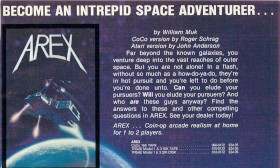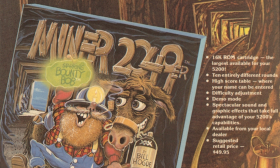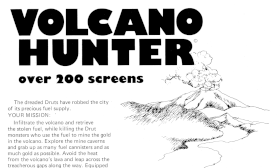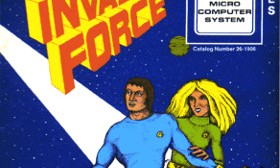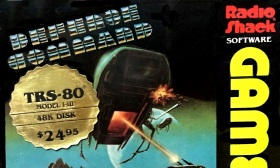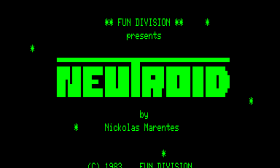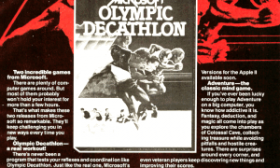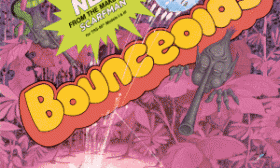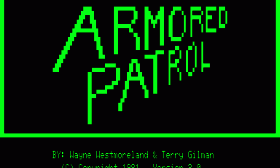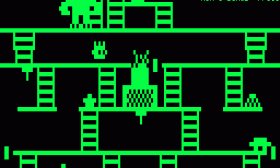Articles in the "Arcade Games" Category
Arex, written by William Muk Koon Yet, was one of the last games Adventure International sold for the TRS-80 Model I and III. It cost $34.95 for both the disk and tape versions when it was released in late 1982. As with many of their other games, Adventure International adapted Arex for multiple computers:
- The Apple II version (for disk only) was written by Gordon Eastman.
- The Atari 400/800 version (for disk and tape) was written by John Anderson.
- The Commodore 64 version (for disk and tape) was a conversion by Philip Case of John Anderson’s Atari version.
- The IBM PC version (for disk only) was written by Philip Case.
- The TRS-80 Color Computer version (for tape only) was written by Roger Schrag.
(Read more...)
Bill Hogue, through his company Big Five Software, was known for producing some of the best games available for the TRS-80 Model I and III. Games like Galaxy Invasion and Robot Attack were legendary in TRS-80 circles. But Bill Hogue and Big Five Software’s most successful game wasn’t for the TRS-80. It was Miner 2049er, the 1984 Electronic Game of the Year. Miner 2049er was an Atari platform game with ten levels that had versions available for more computers than any other game at the time.
Here is a description of Miner 2049er from a 1983 Big Five Software flyer:
(Read more...)
Volcano Hunter was one of the final games to be commercially released for the TRS-80 Model I and III. It was written by David Smith and sold through his company, Lap Video Entertainment. It cost $19.95 for the cassette version and $22.95 for the disk version. A review in 80 Micro described Volcano Hunter as an “ingenious machine-language, arcade-style adventure game.”
Here is David Smith’s description of the game:
You are HUNTING HARRY, the last person left in a town taken over by Druts. (A Drut is a monster that usually lives inside the earth near volcanoes.) The town you live in just happens to be near a volcano. The dreaded Druts have been mining the volcano for its gold, but they have run into a problem. They ran out of fuel for their machines to mine the volcano. So they robbed the city of its precious fuel supply and they plan to keep it. It is your duty to infiltrate the volcano and retrieve the stolen fuel, while killing the Drut monsters who will try and stop you. It may take you a while to find all the fuels because there are over 200 screens in this adventure.
(Read more...)
Invasion Force (catalog number 26-1906) was one of the first action games Radio Shack published for the TRS-80 Model I. It was written by Robert Arnstein and introduced in 1979 on cassette for a price of $14.95. There never was a disk version of Invasion Force.
Invasion Force was very similar to Trek-80, a game for the Sol-20 computer that was probably also written by Robert Arnstein. Here is a description of Invasion Force from an article titled “A New Real-Time Space Adventure That Puts You in Command of Your Own Starship” from the June 1979 issue of the TRS-80 Microcomputer News:
Take command of the USS Hephaestus and protect the galaxy against the hated and feared Jovians. The Command Control Display (TRS-80 screen) places all the ship’s resources at your fingertips.
(Read more...)
Most people considered the Big Five Software games to be the finest games ever written for the TRS-80 Model I and III. They were sold directly through Big Five Software and were resold by many other companies.
Radio Shack also sold Big Five Software games in two collections compiled by Cogito Software. Games Pack Two and Games Pack Three first appeared in the 1984 Radio Shack catalog and contained four Big Five games: Defense Command, Stellar Escort, Cosmic Fighter and Meteor Mission 2. As the packaging stated: “You can look forward to hours of fun for the family, friends, or even the gang at the office.”
Both collections were sold on cassette and self-booting disk. Only minor modifications were made to the games, the biggest being that all copyright messages were changed to “Licensed to Tandy Corporation.
(Read more...)
Neutroid was written by Nickolas Marentes in 1983 and sold through his company, Fun Division (known earlier as Supersoft Software). It was the third of seven games that he wrote for the TRS–80 Model I and Model III. Nickolas Marentes became better known for his later TRS–80 Color Computer games such as Donut Dilemma (which began with a Model I version) and Rupert Rythym.
Marentes was inspired to write Neutroid after reading an interview with Tim Skelly, the author of the 1982 Gottlieb arcade game Reactor. Although Neutroid doesn’t resemble Reactor in any way, they both share a similar abstract concept of manipulating particles within an enclosed space to prevent a nuclear disaster.
(Read more...)
Olympic Decathlon, sometimes known as Microsoft Olympic Decathlon, was one of the first sports related programs to mix game and simulation. It was written by Timothy W. Smith and sold by Microsoft Consumer Products. The original TRS-80 version cost $24.95 and was released in 1980. It was followed by an Apple II version in 1981 and an IBM PC version in 1982. Although the program used both the word “Olympic” in its title and the Olympic rings symbol, the program manual makes no mention of a license from the International Olympic Committee. The lack of a license might be why the 1982 IBM PC version was renamed Microsoft Decathlon and all references to the Olympics were removed.
Contrary to what is sometimes claimed, Olympic Decathlon was not based on the similar Konami arcade game Track and Field, but actually predated it by several years. Olympic Decathlon was created by Timothy Smith, a former systems programmer for Burroughs Corporation. Smith wanted to write a sports game, but didn’t want to pick an obvious sport such as baseball or basketball. Instead, he chose to base a game on the decathlon, a grueling two-day competition that is comprised of ten track-and-field events:
(Read more...)
There were many unofficial adaptations of the Atari arcade game Asteroids written for the TRS-80. Super Nova from Big Five Software and Planetoids from Adventure International were considered among the best.
Bounceoids (not “Bounceroids” as some sources state) was an Asteroids-inspired game written by Robert Pappas (author of Frogger and Crazy Painter) and sold by the Cornsoft Group. It took the concept behind Asteroids and gave it an intriguing twist: what if asteroids didn’t wrap around the sides of the screen, but bounced off the sides instead?
Although this might sound like a minor difference, having the asteroids bounce completely changes the gameplay. The same playing strategies that work in Asteroids (some of which also work in Super Nova and Planetoids) don’t work in Bounceoids. In particular, the movement of the bouncing asteroids means that the player must move almost constantly to avoid them.
(Read more...)
Armored Patrol was one of the most popular TRS-80 games, described by Owen Linzmayer in Creative Computing as “a classic in every sense of the word.” It was distributed by Adventure International and written by Wayne Westmoreland and Terry Gilman, the first of their games for the TRS-80. Unlike their other Adventure International games, Armored Patrol was never ported to any other computers.
Armored Patrol was based on the arcade game Battlezone, released by Atari in 1980. Battlezone used vector graphics to depict a tank battle with a first-person 3‑D view, a real innovation at the time. The player controlled a tank that could rotate 360 degrees. The goal was to destroy the enemy tanks that could be anywhere on the battlefield, even behind the player. Other obstacles were pyramids, which could block the enemy tanks, and even the occasional UFO.
Here is an overview of Armored Patrol from a 1982 Adventure International catalog:
(Read more...)
Wayne Westmoreland and Terry Gilman wrote some of the best games for the TRS-80 Model I and III, including classics such as Sea Dragon and The Eliminator. When Wayne Westmoreland released all of their games to the public domain in 1995, TRS-80 owners received an unexpected treat: Donkey Kong, a previously unreleased TRS-80 game.
Donkey Kong was based on the Nintendo arcade game of the same name from 1981. The hero of the Nintendo game is a carpenter named Mario (who later became better known in the game Mario Bros). The goal is to rescue Mario’s girlfriend Pauline from the marauding Donkey Kong. Mario needs to reach Pauline at the top of the screen, all the while dodging barrels thrown by Donkey Kong. Other obstacles include conveyor belts, elevators, and fireballs.
(Read more...)
